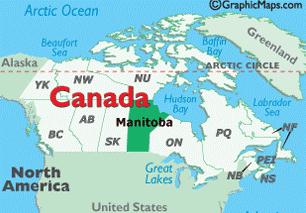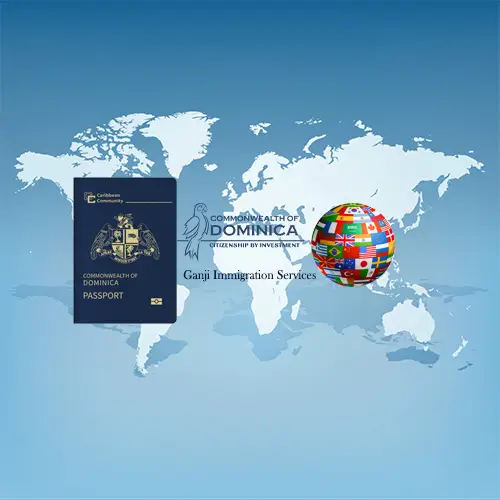
Manitoba
Manitoba is one of Canada’s Prairie Provinces. The province, with an area of 649,950 km2 and a population of 1,208,268, has a largely continental climate, with thousands of lakes and many rivers. Agriculture, mostly concentrated in the fertile southern and western parts of the province, is vital to the province's economy; other major industries are transportation, manufacturing, mining, forestry, energy, and tourism.
Fur traders first arrived during the late 17th century and Manitoba was the heart of Rupert's Land, owned by the Hudson's Bay Company. Manitoba became a province of Canada in 1870 after the Red River Rebellion. A general strike took place in Winnipeg in 1919, and the province was hit hard by the Great Depression.
The name Manitoba is derived from the Cree, Ojibwe or Assiniboine languages which mean “the Great Spirit".
Winnipeg is the capital, largest city and Canada’s eighth-largest Census Metropolitan Area, and home to 60 percent of the population of the province with a population of 730,018. It is located near the longitudinal Center of North America, at the confluence of the Red and Assiniboine Rivers. The city is the seat of government, home to the Legislative Assembly of Manitoba and the highest court in the jurisdiction, the Manitoba Court of Appeal. Four of the province's five universities, both of its professional sports teams, and most of its cultural activities are located in Winnipeg.
The name Winnipeg comes from the Western Cree words for "muddy waters". The region was a trading center for aboriginal peoples before the arrival of Europeans. French traders built the first fort on the site in 1738. A settlement was later founded by the Selkirk settlers in 1812, the nucleus of which was incorporated as the City of Winnipeg in 1873. Since 2011, Winnipeg is the seventh most populated municipality in Canada. Winnipeg is a railway and transportation hub with a diversified economy.
Geography of Manitoba
Manitoba is bordered by the provinces of Ontario to the east and Saskatchewan to the west, the territories of Nunavut and Northwest Territories to the north, and the US states of North Dakota and Minnesota to the south. It adjoins Hudson Bay to the northeast, and is the only prairie province with a salt water coastline. The Churchill port is the only arctic deep-water port in Canada and the shortest shipping route between North America and Asia. Lake Winnipeg is the tenth largest freshwater lake in the world. Hudson Bay is the second largest bay in the world.
The province has a saltwater coastline bordering Hudson Bay and contains over 110,000 lakes, covering approximately 15.6 percent or 101,593 km2 of its surface area. Manitoba's major lakes are Lake Manitoba, Lake Winnipegosis, and Lake Winnipeg, the tenth-largest freshwater lake in the world. The province has many rivers including the Red, Assiniboine, Nelson, Winnipeg, Hayes, Whiteshell and Churchill Rivers.
Manitoba capital, Winnipeg, lies at the bottom of the Red River Valley. It is on the eastern edge of the Canadian Prairies in Western Canada and is known as the "Gateway to the West". Winnipeg is bordered by tall grass prairie to the west and south and the aspen parkland to the northeast. It is relatively close to many large Canadian Shield lakes and parks, as well as Lake Winnipeg (the Earth's 11th largest freshwater lake). Winnipeg contains North America's largest extant mature urban elm forest. The city has a total area of 464.08 km2. Winnipeg has four major rivers: the Red, Assiniboine, La Salle and Seine.
Climate of Manitoba
Manitoba has an extreme continental climate. Temperatures and precipitation generally decrease from south to north, and precipitation decreases from east to west. Manitoba is far removed from the moderating influences of both mountain ranges and large bodies of water, and because of the generally flat landscape, it is exposed to cold Arctic high-pressure air masses from the northwest during January and February. In the summer, air masses sometimes come out of the Southern United States, as warm humid air is drawn northward from the Gulf of Mexico. Temperatures exceed 30 °C numerous times each summer. According to Environment Canada, Manitoba ranked first for clearest skies year round, and ranked second for clearest skies in the summer and for the sunniest province in the winter and spring.
Southern Manitoba falls into the humid continental climate zone. This area is cold and windy in the winter and frequently experiences blizzards because of the openness of the landscape. Summers are warm with a moderate length, and this region is the most humid area in the Prairie Provinces with moderate precipitation. Southwestern Manitoba is closer to the semi-arid interior of Palliser's Triangle. The area is drier and more prone to droughts than other parts of southern Manitoba. This area is cold and windy in the winter and frequently experiences blizzards because of the openness of the landscape. Summers are generally warm to hot, with low to moderate humidity. Southern parts of the province, located just north of Tornado Alley, experience tornadoes each year. The northern sections of the province fall in the subarctic climate zone This region features long and extremely cold winters and brief, warm summers with little precipitation.
Manitoba is home to a diverse species of animals. The province is especially noted for its polar bear population; Churchill is commonly referred to as the "Polar Bear Capital". Other large animals, such as moose, deer, cougars, lynx, and wolves, are common throughout the province.
Winnipeg has a humid continental climate. The province has four distinct seasons, with short transitional periods between winter and summer. Summers are warm with plenty of thunderstorms, winters are cold and dry, and spring and fall are temperate. Snow sometimes lasts six months of the year; and some years the temperature briefly falls to −40.0 °C. Total annual precipitation is just over 51 cm.
History of Manitoba
Manitoba was inhabited by the First Nations people approximately 10,000 years ago. In 1611, Henry Hudson was one of the first Europeans to sail into what is now known as Hudson Bay. The first European to reach what is now northern Manitoba was Sir Thomas Button in 1612, who named the Nelson River. Henry Kelsey was the first European to travel from Hudson Bay to the prairies, reporting the bison and grizzly bears that he saw. Kelsey went as far as present day Saskatchewan.
A British ship sailed into Hudson Bay in 1668–1669, becoming the first fur trading vessel to reach the area. York Factory was founded in 1684 after the original fort of the Hudson's Bay Company, Fort Nelson (built in 1682), was destroyed by rival French traders. Fur trading forts were built by both the North West Company and the Hudson's Bay Company along the many rivers and lakes.
Great Britain secured the territory in 1763 as a result of their victory over France in the Seven Years' War.
Rupert's Land (the original name of the Hudson Bay watershed) was ceded to Canada in 1869 and incorporated into the Northwest Territories. The Métis of Manitoba launched the Red River Rebellion under Louis Riel, and established a provisional government. Negotiations between the provisional government and the Canadian government resulted in the passage of the Manitoba Act which created the Province of Manitoba and provided for its entry into Confederation in 1870. Louis Riel was pursued by British army officer Garnet Wolseley because of the rebellion, and Riel fled into exile.
The original province of Manitoba was a square 1/18 of its current size, and was known as the "postage stamp province". Its borders were expanded in 1881, taking land from the Northwest Territories and the District of Keewatin, but Ontario claimed a large portion of the Keewatin land; the disputed portion was awarded to Ontario in 1889. Manitoba grew to its current size in 1912, absorbing land from the Northwest Territories, uniform with the northern reach of its western neighbors Saskatchewan, Alberta and British Columbia.
Winnipeg was the third-largest city in Canada in the early 20th century. This boomtown grew quickly from the late 19th century to the early 20th century. There were a lot of outside investors, immigration, railways, trains, and business was booming.
After World War I ended, severe discontent among farmers (over wheat prices) and union members (over wage rates) resulted in an upsurge of radicalism, coupled with a polarization over the rise of Bolshevism in Russia. The most dramatic episode was the Winnipeg General Strike of 1919 which shut down most activity for six weeks, starting May 15. The strike collapsed on June 25, 1919, as the workers were gradually returning to their jobs and the Central Strike Committee decided to end the strike.
Winnipeg was inundated during the 1950 Red River Flood and had to be partially evacuated. In that year, the Red River reached its highest level since 1861 and flooded most of the Red River Valley.
Population of Manitoba
At the 2011 census, Manitoba had a population of 1,208,268, more than half of which is in the Winnipeg Capital Region; Winnipeg is Canada's eighth-largest Census Metropolitan Area, with a population of 730,018.
According to the 2006 Canadian census, the largest ethnic group in Manitoba is English (22.9%), followed by German (19.1%), Scottish (18.5%), Ukrainian (14.7%), Irish (13.4%), North American Indian (10.6%), Polish (7.3%), Métis (6.4%), French (5.6%), Dutch (4.9%), and Russian (4.0%).
Manitoba Military bases
CFB Winnipeg is a Canadian Forces Base at the Winnipeg International Airport. The base is home to flight operations support divisions and several training schools, as well as the 1 Canadian Air Division and Canadian NORAD Region Headquarters. 17 Wing of the Canadian Forces is based at CFB Winnipeg. It supports 113 units from Thunder Bay to the Saskatchewan/Alberta border, and from the 49th parallel north to the high Arctic. 17 Wing acts as a deployed operating base for CF-18 Hornet fighter–bombers assigned to the Canadian NORAD Region.
Canadian Forces Base Shilo is an Operations and Training base of the Canadian Forces located in Manitoba. During the 1990s, Canadian Forces Base Shilo was designated as an Area Support Unit, acting as a local base of operations for Southwest Manitoba in times of military and civil emergency. CFB Shilo is the home of the 1st Regiment, Royal Canadian Horse Artillery, both battalions of the 1 Canadian Mechanized Brigade Group, and the Royal Canadian Artillery.
Manitoba Official language
According to the Manitoba Act, English and French are the official languages of Manitoba. In April 1890, the Manitoba legislature attempted to abolish the official status of French, and ceased to publish bilingual legislation.
Although French is an official language for the purposes of the legislature, legislation, and the courts, the Manitoba Act does not require it to be an official language for the purpose of the executive branch. Hence, Manitoba's government is not completely bilingual. According to the 2006 Census, 82.8 percent of Manitoba's population spoke only English, 3.2 percent spoke only French, 15.1 percent spoke both, and 0.9 percent spoke neither.
Economy of Manitoba
Manitoba; economy is based largely on natural resources. Its Gross Domestic Product was C$50.834 billion in 2008. The province's economy grew 2.4 percent in 2008, the third consecutive year of growth; in 2009, it neither increased nor decreased. The average individual income in Manitoba in 2006 was C$25,100 (compared to a national average of C$26,500), ranking fifth-highest among the provinces. As of October 2009, Manitoba's unemployment rate was 5.8 percent.
Manitoba's economy relies heavily on agriculture, tourism, energy, oil, mining, and forestry. Agriculture is vital and is found mostly in the southern half of the province, although grain farming occurs as far north as The Pas. Around 12 percent of Canadian farmland is in Manitoba. The most common type of farm found in rural areas is cattle farming (34.6%), followed by assorted grains (19.0%) and oilseed (7.9%).
Manitoba is the nation's largest producer of sunflower seed and dry beans, and one of the leading sources of potatoes. Portage la Prairie is a major potato processing centre, and is home to the McCain Foods and Simplot plants, which provide French fries for McDonald's, Wendy's, and other commercial chains. Can-Oat Milling, one of the largest oat mills in the world, also has a plant in the municipality.
Manitoba's largest employers are government and government-funded institutions, including crown corporations and services like hospitals and universities. Major private-sector employers are The Great-West Life Assurance Company, Cargill Ltd., and James Richardson and Sons Ltd. Manitoba also has large manufacturing and tourism sectors. Churchill's Arctic wildlife is a major tourist attraction; the town is a world capital for polar bear and beluga whale watchers.
Winnipeg is an economic base and regional center. It has one of the country's most diversified economies, with major employment in the trade (15.2%), manufacturing (9.8%), educational (7.7%), and health care and social assistance (15.2%) sectors. There were approximately 21,000 employers in the city as of 2012. Since January 2014, approximately 416,700 people are employed in Winnipeg and the surrounding area. In 2012, Winnipeg was ranked as the least expensive location to do business in western Canada. In 2013, Winnipeg's economy was rated as fourth in a national survey of 25 city economies, behind Toronto, Calgary, and Regina.
Government and politics of Manitoba
After the control of Rupert's Land was passed from Great Britain to the Government of Canada in 1869, Manitoba attained full-fledged rights and responsibilities of self-government as the first Canadian province carved out of the Northwest Territories. The Legislative Assembly of Manitoba was established on 14 July 1870. Political parties first emerged between 1878 and 1883, with a two-party system (Liberals and Conservatives). The United Farmers of Manitoba appeared in 1922, and later merged with the Liberals in 1932. The Co-operative Commonwealth Federation became the New Democratic Party of Manitoba (NDP), which came to power in 1969. Since then, the Conservatives and the NDP have been the dominant parties.
Like all Canadian provinces, Manitoba is governed by a unicameral legislative assembly. The executive branch is formed by the governing party; the party leader is the premier of Manitoba, the head of the executive branch. The head of state, Queen Elizabeth II, is represented by the Lieutenant Governor of Manitoba, who is appointed by the Governor General of Canada on advice of the Prime Minister. The head of state is primarily a ceremonial role, although the Lieutenant Governor has the official responsibility of ensuring that Manitoba has a duly constituted government.
The Legislative Assembly consists of the 57 Members elected to represent the people of Manitoba. The Conservative Party holds 19 seats, and the Liberal Party has one seat but does not have official party status in the Manitoba Legislature. Last provincial general election was held on 4 October 2011. The province is represented in federal politics by 14 Members of Parliament and six Senators.
Manitoba's judiciary consists of the Court of Appeal, the Court of Queen's Bench, and the Provincial Court. The Provincial Court is primarily for criminal law; 95 percent of criminal cases in Manitoba are heard here. The Court of Queen's Bench is the highest trial court in the province. It has four jurisdictions: family law (child and family services cases), civil law, criminal law (for indictable offences), and appeals. The Court of Appeal hears appeals from both benches; its decisions can only be appealed to the Supreme Court of Canada.
Higher education in Manitoba
The first school in Manitoba was founded in 1818 by Roman Catholic missionaries Winnipeg; the first Protestant school was established in 1820. A provincial board of education was established in 1871.
Public schools in Manitoba fall under the regulation of one of thirty-seven school divisions within the provincial education system. There are sixty-five funded independent schools in Manitoba, including three boarding schools.
There are five universities in Manitoba. Four of these universities are in Winnipeg: the University of Manitoba, the largest and most comprehensive; the University of Winnipeg, a liberal arts school primarily focused on undergrad studies located downtown; Université de Saint-Boniface, the province's only French-language university; and the Canadian Mennonite University, a religious-based institution. The Université de Saint-Boniface, established in 1818 and now affiliated with the University of Manitoba, is the oldest university in Western Canada. Brandon University, formed in 1899 and located in Brandon, is the province's only university not in Winnipeg.
Manitoba has thirty-eight public libraries; of these, twelve have French-language collections and eight have significant collections in other languages. Twenty-one of these are part of the Winnipeg Public Library system. The first lending library in Manitoba was founded in 1848.
Transportation in Manitoba
Transportation and warehousing contribute approximately C$2.2 billion to Manitoba's GDP. Total employment in the industry is estimated at 34,500, or around 5 percent of Manitoba's population. 95 percent of land freight in Manitoba is done by Trucks, and trucking companies account for 80 percent of Manitoba's merchandise trade to the United States. Five of Canada's twenty-five largest employers in for-hire trucking are headquartered in Manitoba.
Greyhound Canada and Grey Goose Bus Lines offer domestic bus service from the Winnipeg Bus Terminal. The terminal was relocated from downtown Winnipeg to the airport in 2009.
Manitoba has two Classes I railways: Canadian National Railway (CN) and Canadian Pacific Railway (CPR). Winnipeg is centrally located on the main lines of both carriers, and both maintain large inter-modal terminals in the city. CN and CPR operate a combined 2,439 kilometers of track in Manitoba.
Winnipeg James Armstrong Richardson International Airport, Manitoba's largest airport, is one of only a few 24-hour unrestricted airports in Canada and is part of the National Airports System. The airport handles approximately 195,000 tons of cargo annually, making it the third largest cargo airport in the country.
The Port of Churchill, owned by OmniTRAX, is the only Arctic deep-water port in Canada. It is nautically closer to ports in Northern Europe and Russia than any other port in Canada.










